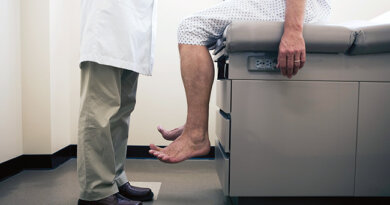Feeding Your Puppy The Right Way From the Very Start
By Janice Jones |Last Updated 04-30-2020
Feeding Your
Puppy should be a fun bonding experience for both of you. But if you are a new puppy owner or someone who has not had a puppy in a while, you might be wondering how to start off right–what to feed, how much to feed, when to feed.
These are just a few of the many questions new puppy owners have. If you are one of those, read on.
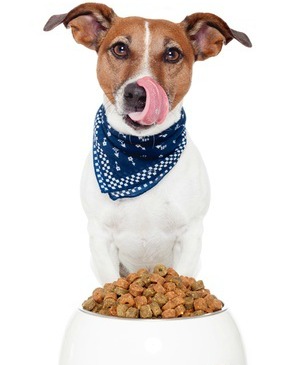 Feeding Your Puppy
Feeding Your PuppyFeeding Your Puppy: What to Feed?
Puppies have different nutritional needs than adult dogs and therefore require a different diet. There is a wide range of types and quality when it comes to dog foods and puppy foods are no exception.
When you get your new puppy, you will want to ask the breeder what food the puppy has been eating. Chances are good the food was a dry kibble, a combination of kibble and can or possibly a combination of raw and something else.
It’s important to continue feeding your puppy that food, at least initially but it doesn’t mean you need to stick with it for the rest of the dog’s life.
Breeders vary widely in their interest in nutrition and some may skip corners when it comes to the food they feed their puppies. At the other extreme, you may find that your breeder feeds a food that is just too expensive for your budget.
Luckily there is always a good choice of dog food for all dogs. That doesn’t mean that there is one perfect food. Your job is to figure out the perfect food for feeding your puppy.
Dog food comes in an amazingly sophisticated assortments of brands, flavors, and forms and if you are new to the dog community, you may want to start by learning about all the different types of dog foods available today.
Finding the highest quality puppy food your budget will allow will keep your puppy healthier over the course of a lifetime and cut down on veterinary bills. To learn more, check our our article on choosing the best puppy foods.
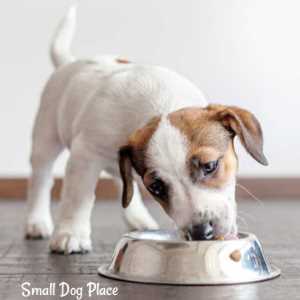 Feeding Your Puppy: What to Feed
Feeding Your Puppy: What to FeedFeeding Your Puppy: How Often?
Most puppies are completely weaned by six to eight weeks of age and many are ready to move on to their forever homes. Some small breed puppies do not leave the breeders home until they are 12 weeks of age.
By this time, they are eating real food and feeding your puppy will be your responsibility.
Very young puppies under 10-12 weeks of age may need four feedings per
day. Most experts
suggest that puppies be feed three times a day until they are 6 months old,
then 2 times a day throughout their lifespan.
You do not need to rearrange your schedule to accommodate a small puppy, but consistency is very important. Meal times should be at the same time daily.
Most experts
agree that the best way to feed a puppy is by scheduled meal times rather than
free feeding which is leaving food out at all times where puppies are able to
eat ad lib.
One advantage to a scheduled
feeding routine is that you are more in control and have a better idea how much
food your puppy is consuming. Even more
important, scheduled feedings allow you to potty train your puppy faster.
If you have control over feeding your puppy,
you will also gain control over their house training routine. On the other hand, some puppies are so tiny, that hypoglycemia may become a problem.
Should you free feed or schedule meal times?
Feeding Your Puppy: How Much?
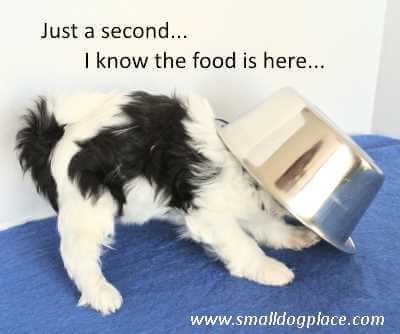 Feeding Your Puppy: How Much?
Feeding Your Puppy: How Much?Reading the dog label may give you an idea about how much to feed, but all dogs are different so that should only be a starting point. Read the
package directions for the amount of food to feed.
Divide that amount by the number of meals you
will serve (two or three). Serve and
allow the puppy to eat. Remove uneaten food
after about 20 minutes. A very slow
eater may need a few extra minutes. Use
your judgment.
The best advice that I can give is to put out a portion of food and see how much your dog eats in 20 minutes or less. I know that doesn’t sound very scientific, but I’ll get to that in a minute.
If your dog is eating well, gaining weight, active and showing all signs of health, he’s probably eating the correct amount.
Use the
package directions only as a guide. Very
active puppies may need more than their less active cousins. If you are in the process of training
throughout the day and plan to use treats as reinforcement, take those extra
calories into consideration when feeding a meal.
People tend to make puppies and adults overweight, not the dogs themselves.
If you feel the puppy is getting too many of
his calories from treats, use a portion
of the kibble that you would normally feed at mealtime to treat when training.
Monitor your
puppy’s weight. You should be able to
feel ribs but not see them. If you can
not feel any ribs, you might want to cut back just a little.
Everything
that goes into his little mouth is part of his daily caloric intake (treats and
handouts from the table included).
Puppies can get very porky if they get into the habit of begging while
you are eating.
It’s easy to see why
people will feeding the puppy just a little handout here and there, but once
this habit begins, it is extremely difficult to break.
If feeding a puppy is starting to sound a bit too complicated, it need not be so. There are online calculators you can use to determine how much to feed, how many calories your are providing and what it will cost you. One such dog food calculator, asks you to input a few of your dog’s details (dog’s age, activity level, neuter status) and type of food you are feeding and it will provide you with a daily recommended calorie count, cups of foods to feed and the cost. It’s worth a look.
Once a puppy has had a tidbit from the table,
you will never have another mealtime without the puppy jumping up wanting more
and more. The moral of the story is Don’t
Start!
Calorie/Energy Need Considerations When Feeding Your Puppy
Puppies need more energy/calories than adult dogs due to their rapid growth rate. The National Research Council of the National Academies recommends puppies receive twice as many calories per pound of body weight as adults.
A good ballpark figure for dogs is about 30 calories per pound per day for an adult dog. Small breed dog may need more than that. This means on average that small breed puppies will need about 60 calories per day. So a five pound puppy would require 300 calories a day.
That may seem like a lot, but remember you are feeding your puppy three meals a day until he reaches 6 months. The best way to determine how much to feed, again is to look at the label. Each food is different so the calories present in one cup of dog food will not be the same as in the next brand.
Counting calories is only part of the equation. To feed a puppy correctly, he needs the correct type of ingredients in the proper amounts so that his diet is balanced.
Even very poor dog food can be balanced and will sustain your puppy’s life, but your dog will not enjoy a healthy lifestyle. So the process of feeding your puppy can become rather complicated.
As a side note, it is really hard to do this if you plan to put your puppy on a homemade diet. Rather it is easier to find a food that has all the ingredients in the proper portions.
What type of Nutrients Does Your Puppy Need?
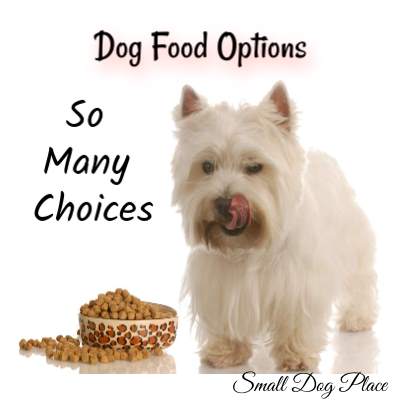
Puppies and Dogs need three major macronutrients (protein, fats, and carbohydrates) and a variety of micronutrients (vitamins and minerals) to survive. They like all other creatures need water to sustain life.
The American Association of Feed Control Officers (AAFCO) provides minimal guideline for what puppies and adult dog food should contain. Take a look at just a few of their recommendations.
Protein: Adults 18% Puppies 22%
Fats: Adults 5% Puppies 8%
and it doesn’t stop there. The AAFCO recommended specific amounts for each amino acid, fat, and mineral present in the food.
Proteins
Protein is made up of various amino acids and provides energy. There are two types of amino acids, essential and nonessential.
Essential amino acids can only be acquired through the diet whereas the body can make the nonessential amino acids. It is the principal structural component of the body tissue and organs.
High quality proteins in puppy food include real meats such as chicken, turkey, or beef or named fish sources such as salmon. Some poorer quality foods will use plant based sources such as corn or peas to boost the protein levels. Unnamed meat protein can be downright dangerous.
Carbohydrates
Carbohydrates include sugars, starches, and fiber and functions to provide energy and assist with proper gastrointestinal functioning.
Carbohydrates can be obtained through plant based foods such as fruits and vegetables. When carbohydrates are consumed in quantities that the body can’t use, they are converted to fat.
Fats
Fats supply energy and the essential fatty acids that the body cannot produce. They are also have numerous structural and metabolic functions.
The highest quality fat sources come from named animal sources such as chicken fat. Some fats found in dog food also contain plant based sources such as vegetable oil.
Minerals
Minerals comprise all of the inorganic elements in foods and play a large role in enzyme and hormone systems. The long list of ingredients you see on the dog food label is usually the names of specific minerals or vitamins added. Examples of minerals include calcium, phosphorus, potassium and zinc.
Vitamins
Vitamins are either water soluble such as the B-complex vitamins or fat soluble such as A, E, and K. The play a role in DNA synthesis and serve as co-factors in enzyme reactions.
Most vitamins in dog food must be added back into the mix after the dog food is made because the heat intensive manufacturing process strips most of the vitamins from the food.
For more information of Canine Nutrition, you might want to check out this other article. Or, 7 Signs Your Pup’s Diet is Not Ideal.
Combining Puppy Foods
There is no reason
why you cannot feed two different foods as long as they are both labeled for puppies or all
life stages. Some people will feed dry
in the morning and then mix canned and dry with a little warm water in the
evening.
Some people prefer to use just
dry because they believe that crunching up dry kibble is a good way to keep
their puppy’s teeth clean. It is true
that puppies need many opportunities to chew, especially while they are
teething.
The best way to keep puppy’s
teeth clean is to brush their teeth. No
amount of dry food will keep teeth cleaner than you can do with a toothbrush.
Should You Alternate Foods?
Many people
will tell you to find a food and stick with it.
It is true that changing foods should be done cautiously, but there are
advantages to using different foods.
Even
the best foods may lack something your puppy needs. Periodically changing out foods assures that
over the long run, your puppy will be getting the best nutrition possible. Remember you would never want to eat the same food day in and day out for a lifetime.
Changing
foods abruptly may cause diarrhea in puppies.
To change out foods, consider using the following schedule:
| Day One | Day Two | Day Three | Day Four | Day Five |
|---|---|---|---|---|
| 100% Old Food | 75% Old Food | 50% Old Food | 25% Old Food | 0% Old Food |
| 0% New Food | 25% New Food | 50% New Food | 75% New Food | 100% New Food |
If you notice
a considerable change in your puppy’s stool consistency, you might need to
stretch out this schedule for an additional few days.
Visit your
veterinarian regularly throughout that first important year to check the puppy’s
weight and discuss dietary concerns.
What About Treats?
Training is a
very important activity that you will do with your puppy. Most trainers believe that food incentives
are a useful adjunct to training.
It is
easy to over-feed, especially if you are diligent in your training tasks. Everything that the puppy ingests should be taken
into consideration when determining his overall daily caloric intake.
Choose treats
that are just as nutritious as your regular food. Substitute other treats such as carrot sticks
or tiny bits of chicken. If you prefer a
commercially available treat, choose one that has the same high value as your
food. Use vegetables as treats or serve fruit snacks occasionally.
How to Pick the Best Puppy Food
Dr. Karen Becker has made a few videos about choosing a good puppy food. She is a strong advocate for biologically available foods.
Here is a list of 10 tips for feeding your puppy a great diet according to Dr. Becker
- Choose food that has a named protein in the the first couple of slots on the label such as Chicken, chicken meal.
- Choose foods that have a named animal fat source such as chicken fat rather than animal fat.
- Choose foods that are whole foods such as sweet potatoes
- No need to purchase foods that include organic grains. They are not biological appropriate for dogs.
- Avoid foods with BHT and BHA potential carcinogens
- Avoid Propylene glycol in dog treats
- Purchase foods made in the U.S.
- Raw, Canned or dehydrated raw are Dr. Becker’s top choices.
- Dog foods don’t need to contain sugar.
- Avoid split grain sources such as corn, corn gluten, corn flour, corn meal all in the same food.
If you found this article, Feeding Your Puppy helpful,
You might like to check out these other resources.
Does This Article Deserve Your Thumbs Up?
We always appreciate your support and encouragement. Your thumbs up means so much to us.

Free Monthly Newsletter
Sign Up for Our Free Newsletter and get our Free Gift to You.
my E-book, The Top 10 Mistakes People Make When Choosing a Dog (and how to avoid them)
If you enjoyed this page, I’d love it if you’d let me know. Just click the button below. Thank you.
Sharing is Caring


